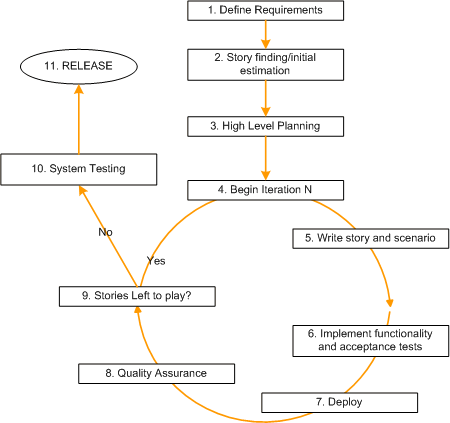“What is Agile Software Development?”
There are lots of defenitions available about Agile Software Development, but i think i should better explain this with a simple defenition.
An iterative and incremental (evolutionary) approach to software development
which is performed in a highly collaborative manner
by self-organizing teams within an effective governance framework
with “just enough” ceremony
that produces high quality software
in a cost effective and timely manner
which meets the changing needs of its stakeholders.
Agile software development refers to a group of software development methodologies based on iterative development, where requirements and solutions evolve through collaboration between self-organizing cross-functional teams. The term was coined in the year 2001 when the Agile Manifesto was formulated.
Agile methods generally promote a disciplined project management process that encourages frequent inspection and adaptation, a leadership philosophy that encourages teamwork, self-organization and accountability, a set of engineering best practices intended to allow for rapid delivery of high-quality software, and a business approach that aligns development with customer needs and company goals. Conceptual foundations of this framework are found in modern approaches to operations management and analysis, such as lean manufacturing, soft systems methodology, speech act theory (network of conversations approach), and Six Sigma.
How does it works?
The diagram explains much more in simpler way. This is a diagram for Agile in Story Writing.

Agile methods break tasks into small increments with minimal planning, and do not directly involve long-term planning. Iterations are short time frames (“timeboxes”) that typically last from one to four weeks. Each iteration involves a team working through a full software development cycle including planning, requirements analysis, design, coding, unit testing, and acceptance testing when a working product is demonstrated to stakeholders. This helps minimize overall risk, and lets the project adapt to changes quickly. Stakeholders produce documentation as required. An iteration may not add enough functionality to warrant a market release, but the goal is to have an available release (with minimal bugs) at the end of each iteration. Multiple iterations may be required to release a product or new features.
Team Composition/Formulation
Team composition in an agile project is usually cross-functional and self-organizing without consideration for any existing corporate hierarchy or the corporate roles of team members. Team members normally take responsibility for tasks that deliver the functionality an iteration requires. They decide individually how to meet an iteration’s requirements.
Team Communication & Work
Agile methods emphasize face-to-face communication over written documents when the team is all in the same location. When a team works in different locations, they maintain daily contact through videoconferencing, voice, e-mail, etc.
Most agile teams work in a single open office (called bullpen), which facilitates such communication. Team size is typically small (5-9 people) to help make team communication and team collaboration easier. Larger development efforts may be delivered by multiple teams working toward a common goal or different parts of an effort. This may also require a coordination of priorities across teams.
Team Communicate with Stake Holders/Clients?
No matter what development disciplines are required, each agile team will contain a customer representative. This person is appointed by stakeholders to act on their behalf and makes a personal commitment to being available for developers to answer mid-iteration problem-domain questions. At the end of each iteration, stakeholders and the customer representative review progress and re-evaluate priorities with a view to optimizing the return on investment and ensuring alignment with customer needs and company goals.
Most agile implementations use a routine and formal daily face-to-face communication among team members. This specifically includes the customer representative and any interested stakeholders as observers. In a brief session, team members report to each other what they did yesterday, what they intend to do today, and what their roadblocks are. This standing face-to-face communication prevents problems being hidden.
Final Throughts & Conclusions
Agile emphasizes working software as the primary measure of progress.
This, combined with the preference for face-to-face communication, produces less written documentation than other methods—though, in an agile project, documentation and other artifacts rank equally with a working product.
The agile method encourages stakeholders to prioritize wants with other iteration outcomes based exclusively on business value perceived at the beginning of the iteration.
Agile methods are a family of development processes, not a single approach to software development.
The Agile Manifesto states:
We are uncovering better ways of developing software by doing it and helping others do it. Through this work we have come to value:
- Individuals and interactions over processes and tools
- Working software over comprehensive documentation
- Customer collaboration over contract negotiation
- Responding to change over following a plan
That is, while there is value in the items on the right, we value the items on the left more.
Some of the principles behind the Agile Manifesto are:
- Customer satisfaction by rapid, continuous delivery of useful software
- Working software is delivered frequently (weeks rather than months)
- Working software is the principal measure of progress
- Even late changes in requirements are welcomed
- Close, daily cooperation between business people and developers
- Face-to-face conversation is the best form of communication (co-location)
- Projects are built around motivated individuals, who should be trusted
- Continuous attention to technical excellence and good design
- Simplicity
- Self-organizing teams
- Regular adaptation to changing circumstances
Agile software development is good when
- Low criticality
- Senior developers
- Requirements change often
- Small number of developers
- Culture that is on Utter Confusion
More Referances Visit
Examining Agile Manifesto by Amby Soft
Discover more from C4: Container, Code, Cloud & Context
Subscribe to get the latest posts sent to your email.